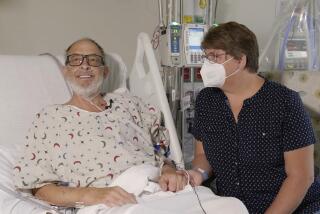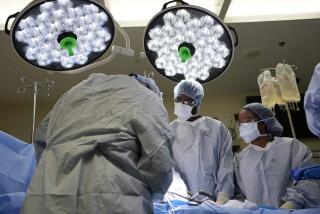Science / Medicine : COMMENTARY : ‘Miracles’ May Leave More Victims Than Heroes
- Share via
Having endured more than 21 hours of highly experimental, horrendously expensive surgery, little Alyssa Smith has earned the right to join Barney Clark, William Schroeder and Baby Fae in the pantheon of modern American medical “heroes.”
While we all hope for her recovery, we should not forget that there is a real question whether the 21-month-old liver transplant recipient and her mother--who donated part of her own liver--are in reality victims of our love affair with modern medical “miracles.”
Alyssa Smith is one of an estimated 700 children who are born each year for whom a liver transplant may be a life-saving necessity.
Among the serious drawbacks of liver transplantation is the major shortage of donor organs. In fact, it is estimated that fully half the children awaiting transplants die before surgeons locate an appropriate donor organ.
To overcome this obstacle and, they hope, to increase the operation’s chance of success, a handful of surgeons around the world have been experimenting with using a portion of the liver of a living donor who is related to the child needing a transplant.
Alyssa Smith’s operation was the first such procedure in the United States. The surgeons in Chicago who operated on her have, for the past five years, been implanting parts of cadaver livers into children. Using this procedure it is potentially possible for several children to benefit from the donation of a single organ.
As in all transplant procedures, the use of a living, related donor organ is preferable to a cadaver organ because rejection is less likely to be a problem, and the organ is “fresher” at the time of the transplant.
But the use of living, related donors raises enormous ethical problems. Simply put, how can a parent be expected to make an informed, rational, free choice when asked to consider donating an organ to his or her own dying child?
Do we really think that Alyssa Smith’s mother had any real idea what risks she was taking, or that she cared, when it was suggested that she be a donor? Did she understand what might happen to her during 17 hours of surgery? Does she feel any differently about things now that she has not only donated part of her liver, but has also lost her spleen--because surgeons damaged it accidentally and had to remove it?
How do we address the question of whether parents, or siblings, should be compelled to donate organs to their children or brothers and sisters? True, no one is talking about compelling relatives to donate--although there have been court cases involving unsuccessful attempts to coerce relatives into donating bone marrow. But what is the difference between compelling a parent to donate an organ and asking that parent? Obviously, only the rare ones would feel that they could say no, even if that was what they wanted to do.
Even if we feel the problem of free and informed consent can somehow be overcome, we are faced with a question of financial fairness and equitable distribution of scarce medical resources.
If we were to provide liver transplants to the children who could benefit from the operation, we would be paying $210 million to care for 700 children in a single year. And given that only about two-thirds of those children will survive a year after surgery, we are really paying $210 million to save 461 children--or $455,531 per child.
Yes, every child’s life is invaluable. Yes, every life is precious. But, yes, I am suggesting that certain levels of expenditure are obscene and do a great injustice to our concept of social justice.
Consider, for a moment, what might be done instead with that $210 million. If that money were divided among the 20 states with the highest infant mortality rates in the country, each of those states would have about $10 million to provide obstetric and pediatric care to women and children at high risk. That money could go a long way toward greatly reducing our nation’s shamefully high infant mortality rate.
Is it right to spend $210 million on high-tech care for 700 little medical “heroes,” when that same money could save literally thousands of children who are dying because they do not receive the most basic medical care?






